Please Take Note: This is a review of the game’s final prototype. The art, game bits, and the rules discussed are all subject to change. The game is being reviewed on the components and the rules provided with the understanding that “what you see is not what you might get” when the game is published. If you like what you read and want to learn more, we encourage you to visit the game’s web site or visit the Kickstarter campaign. Now that we have all that disclaimer junk out of the way, on with the review!
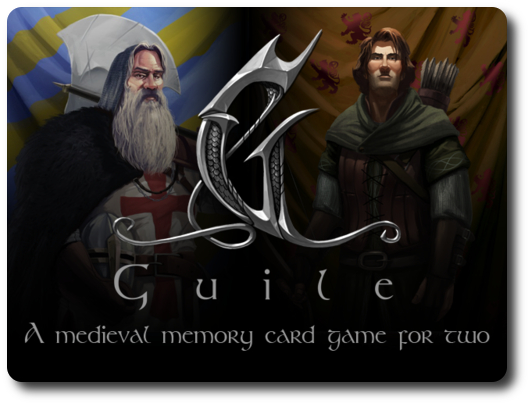
The Basics:
- For ages 5 and up (publisher suggests 8+)
- For 2 players
- Approximately 20 minutes to complete
Geek Skills:
- Counting & Math
- Logical & Critical Decision Making
- Memorization
- Strategy & Tactics
- Risk vs. Reward
- Bluffing and Misdirection
Learning Curve:
- Child – Easy
- Adult – Easy
Theme & Narrative:
- Treachery abounds in this game of ever shifting loyalty and influence
Endorsements:
- Gamer Geek approved!
- Parent Geek approved!
- Child Geek approved!
Overview
The legend of King Arthur is loaded with heroic deeds and betrayal. At the very heart of King Arthur’s kingdom, the Round Table, deceit spreads like a disease. No one can be trusted fully and the forces that would see King Arthur fall work hard to influence and corrupt the king’s most trusted Knights. The true ruler of the kingdom and of the Round Table is the player who is the most cunning and knows that loyalty is a very fickle thing.
Guile, designed by Justin Schaffer and to be published by Terra Nova Games, will reportedly be comprised of 4 Allies of King Arthur Knight cards, 4 Pawns of Sir Mordred Knight cards, 10 Influence cards, 1 Cycle card, 1 Turn card, and 3 Victory cards. As this is a preview of a prepublished game, we will not comment on the game component quality. However, we were very impressed with the proposed artwork and how complete the game felt.
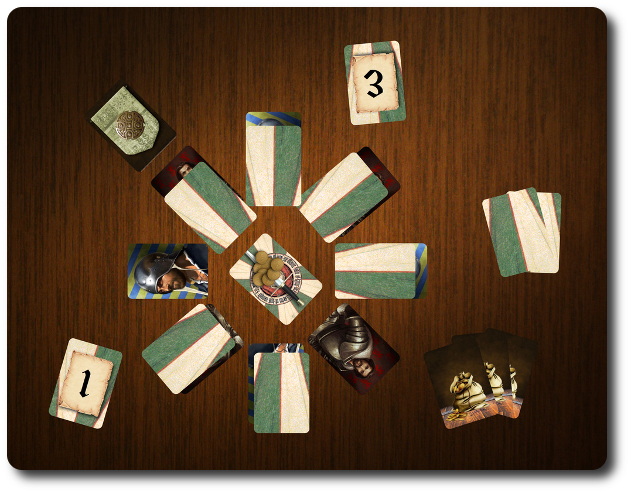
Holding Court
To set up the game, first separate the cards into different groups by type. This will make the rest of the game set up go very quickly. There are very few cards in this game, so if it takes you more than a minute to complete this step, you are doing it wrong.
Second, decide which player will play as King Arthur and which player will play as Sir Mordred. Neither role has an advantage over the other. Then place the Allies of King Arthur and the Pawns of Sir Mordred in the center of the playing area in a circle and in alternating order. This area is referred to as “the Round Table” and all the Knights who sit on it have mixed and fickle loyalties. When completed, your playing area should look similar to the following image.
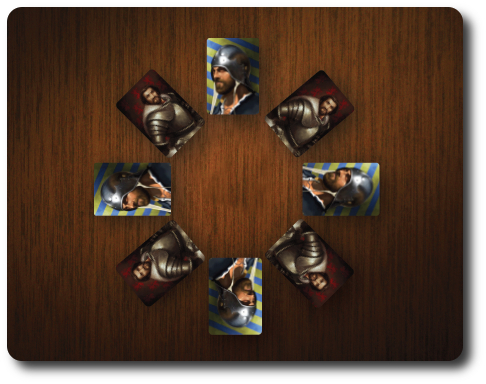
Third, determine which player will go first. We suggest you let the less experienced player have the honor. While there is no advantage obtained as the first player, it does a lot to give a new player confidence. Place the Turn card on the outside of the Round Table and next to one of the first player’s Knights. In the center of the Round Table, place the Cycle card (coin side down) and orientate it so the end of the sword is pointing to the Knight card that has the Turn card next to it.
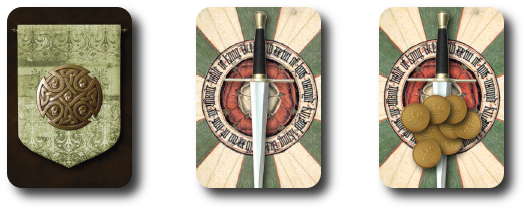
Turn card (left) and the two sides of the Cycle card (center and right)
When completed, your playing area should look similar to the following image.
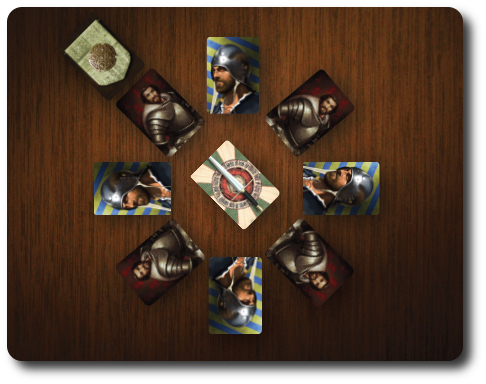
Fourth, shuffle and deal out to each player 4 Influence cards. Players should look at their cards but keep them hidden from their opponent at all times. The remaining 2 Influence cards should be placed, face-down, to the side of the playing area. They are out of the game for the moment.

The Influence cards – only 8 out of the 10 will be used during a game round
Fifth, each player now places 1 of their Influence cards on each of their Knights seated at the Round Table, face-down. Again, players should make certain that their opponent doesn’t see the Influence cards! If playing with Child Geeks, we suggest you let each player place their cards while the other player closes their eyes or looks away. This ensures that both players don’t accidentally let their opponent know the value of their cards. When placing the Influence cards, ensure that the edge of all the player’s Knights are showing. This will help the player’s keep track of which cards they own (red lions for King Arthur and blue/yellow for Sir Mordred).
When completed, your playing area should look similar to the following image.
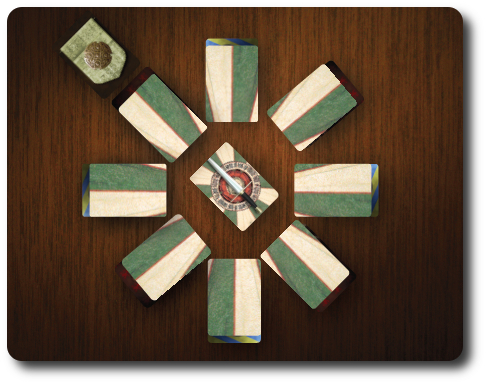
Sixth, place the 3 Victory cards to one side of the playing area. They will be used later in the game.
That’s it for game set up! Let’s play the game!
Something Rotten in the Kingdom of Camelot
The game is played in turns and rounds, with each player being given a total of 8 turns per round. At most, a full game will consist of 3 rounds, but no less than 2. While the approximate time to complete a game is about 20 minutes, expect your first game to take a bit longer and all subsequent games with experienced players to take as little as 15 minutes to complete. A game round and a player’s turn is summarized here. A player knows it’s their turn when the Turn card is directly above one of their Knight cards seated at the Round Table.
Step 1: Take an Action
On their turn, a player can take 1 out of possible 2 actions. They are as follows:
Look at Knight-Errant’s Influence
The Knight-Errant is the only card to have the Turn card next to it, ever. It also happens to be one of the four cards the player owns, which signifies it’s the player’s turn. For their action, the player can look at the Influence card currently on top of the card. When doing so, the player should make certain that their opponent doesn’t see the Influence card’s value. When done looking at the card, it’s placed back on top of the Knight-Errant.
Exchange Influence Cards
The player can swap the location of any 2 Influence cards, but when doing so, one of the two Influence cards must belong to the Knight-Errant and the player cannot look at either of the Influence cards’ values. They should also swap them carefully to ensure that their opponent doesn’t see them either.
Step 2: Rotate the Turn Card
Once the player is done with step 1 above, the Turn card now rotates clockwise around the Round Table and stops at the next Knight card. This is the new Knight-Errant that should belong to the next player if the game was set up correctly.
Step 3: Check the Cycle
The third step is to determine if the Turn card has completed 1 full rotation of the Round Table. A full rotation is completed when the Turn card travels the entire circumference of the Round Table and ends its movement on the same Knight card it started on (as indicated by the position of the Cycle card). If it has, the Cycle card is now flipped over to reveal the other side, which shows the same sword (presumably Excalibur), but with coins on it. This signifies that the second half of the round has begun. The player now takes their turn as indicated in step 1.
If, however, the Turn card has completed its second rotation around the Round Table, the round is over and the players immediately go to scoring.
Scoring the Round and Winning the Game
At the end of a round, all the Influence cards are flipped over and revealed. Players count and total the values of the Influence cards that are on the Knight cards they own. The player with the highest score wins the round and collects a Victory card. The Victory card is placed in front of them or off to the side. If there is a tie, the player who currently controls the highest valued Influence card wins the round. If there is still a tie, the player who owns the Influence card with a dagger on it wins the round.
The round is now complete. All 10 Influence cards are collected, shuffled, and 4 new Influence cards are dealt to each player. The players once again assign an Influence card to each of their Knights. The Turn card is shifted clockwise on position and the Cycle card is rotated accordingly. The first player for the new round should now be the player who went second in the previous round.
And so the game continues until one player has won 2 Victory cards. This player is now the new ruler of Camelot! All hail the King!
To learn more about Guile, visit the game’s web page or visit the Kickstarter campaign.
Prediction
At first glance, I wasn’t the least bit impressed with Guile. It read like a simple memory game. Not a bad game, mind you, but one that didn’t seem to have much in the way of game play. My suspicions regarding the game’s lack of depth were further reinforced after I read the very short rules that only describe two possible actions the player could take on their turn. Very limiting and there wasn’t much there to suggest that the player had much control over the components on the game table. I had fears of players simply shifting the same cards around because they knew what they were, resulting in a strange medieval-themed game of loyalty Ping Pong.
“This can’t be it…”, I said to myself. I set up the game, played a few turns solo, and felt…nothing. “Uh-oh”, I murmured.
This is why I like the prediction portion of the our reviews so much. It gives me an opportunity to share with you how I feel about the game without first playing it. I am often times surprised how absolutely right and absolutely wrong I can be with my predictions in regards to our group’s level of endorsement. Speaking of which, I think the game will frustrate the heck out of most of our players. This would appear to be nothing more than a memory game. I take that back; this is a shell game. The player’s know where their Influence cards are, but as the game continues, they shift around. Can the player’s keep track of their Influence cards? And more to the point, can they keep track of their cards and take a quick peek at their opponents? Using the limited actions, the player will need to determine how best to manage the Round Table on each of their turns.
For the Child and Parent Geeks, I predict mixed results. The games speed and chaotic tendencies might cause some of our Child Geeks to break down and cry out of bitter frustration when they can’t keep track of the Influence cards. For the Parent Geeks, their mixed results will come from being torn by the benefits and challenges of playing a memory game, but only to be greatly reduced in values as they deal with their emotionally and mentally drained Child Geeks.
For the Gamer Geeks, I don’t think the game will do well. Unless, of course, there is something hidden in the metagame that I can’t see yet until I observe a game between two skilled players. Right now, Guile looks just like a memory game with a neat theme and narrative. But that’s it. That’s not nearly enough to even get the Gamer Geeks to take the game seriously.
Teaching the game is exceedingly simple, but do make sure you emphasis the importance of keeping track of as many Influence cards as possible and how a single game round is played. We didn’t have any trouble teaching the game to players as young as 5-years-old and to non-gamers. There really isn’t much in the way of rules to Guile to begin with and the most challenging portion of the game is simply keeping track of card positions. And so, after teaching the game to my Child Geeks, I asked them their thoughts on Guile so far.
“I like the cards a lot and I like the idea of the game, but I don’t really like memory games all that much.” ~ Liam (age 8)
“This is an easy game, Dad! Even I can play it!” ~ Nyhus (age 5)
My 5-year-old is way too modest. He’s played much more complicated games and is more than capable of playing Guile. It’ll be interesting to see if Guile does anything for my 8-year-old who is within the game publisher’s suggested minimum age range. Let’s play and see if the game loyally delivers a fun experience or is a treacherous dog and spoils our gaming fun.
Final Word
Wow.
Let me first say I completely underestimated Guile. I incorrectly assumed it was nothing more than a memory game. I could not have been more wrong. There is a great deal more to Guile than the game rules suggest or the simple game components would even hint at. Much like Checkers that doesn’t look all that difficult or deep when you first observe it, Guile opens itself up to reveal a very complex and intriguing metagame underneath its surface.
For the Child Geeks, Guile started out pretty much as expected. All the player’s knew where their cards where and then lazily looked at their opponent’s cards. Sometimes they moved them and sometimes they didn’t. For our younger Child Geeks, Guile left them unimpressed. For our older and more experienced Child Geeks, Guile took on a new level of complexity. The older Child Geeks started to “get the game”, so to speak, when they saw their opponent’s moving cards that they didn’t know anything about. Doubly so when their opponent moved cards on their Knights! That’s when the bored looks on their faces were replaced by stern eyebrows and smug smirks. The younger Child Geeks thought Guile was “OK” at best with the older Child Geeks really enjoying their time with it. We took into consideration that the game publisher suggested 8-years-old and above. All our players 8 and up enjoyed Guile. In the end, the vote went to approve Guile for the Child Geeks, but a word of caution. Understand that Guile is a game that demands little of its players, but puts all the responsibility of providing the game’s depth on their shoulders. If an opponent is unable or unwilling to play the game on a more competitive level, it will come across as only a memory and guessing game. For those Child Geeks who love games where they get to try to out think, out smart, and out manuever their opponents, Guile is going to deliver. But a younger player can very easily be outclassed by the skills of a more experienced player. That’s pretty common in most games, but very visible and painfully felt in a 2-player game.
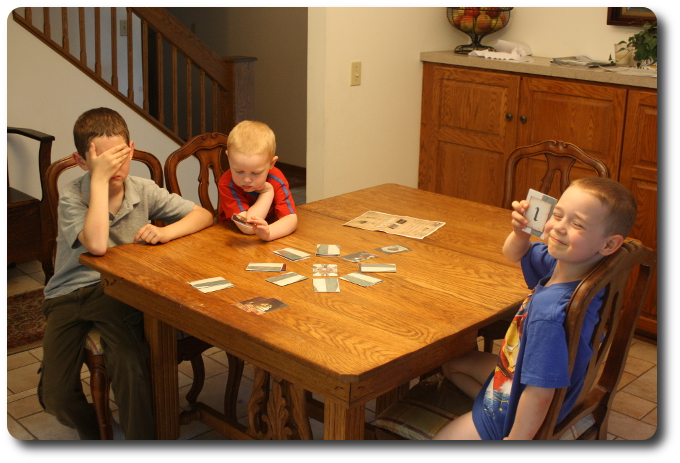
We’ve gotten into the habit of closing our eyes when playing with our 5-year-old..
The Parent Geeks first opportunity to play the game was with their peer group. The first half of the first round could best be described as “getting the feel of the game”. The vibe and play style of all our players during the second half of the first round always shifted from borderline disinterest to full-out aggressive cunning. The Parent Geeks who play games on a regular basis quickly began to understand what was necessary to win against their opponent. The non-gamer Parent Geeks were not as quick to pick it up, but by the second round, they were just as crafty and deceptive as their more geeky peers. Then the game crashed when they played it with their Child Geeks. Guile is a game that has a lot of “potential depth and engaging game play”. Players have to bring their own shovels, however, if they care to dig for it. Guile presents to its players a very simple set of rules and never once defines or suggests what tactics and strategy a player should use. I personally think this is a genius move, although some of our players suggested it was laziness on the part of the game publisher. Many of the Parent Geeks, including myself, really enjoyed that moment of serendipity when we realized that Guile was a whole lot more than what we thought it was. But that realization only occurs when you play against an opponent that’s equal to or better skilled. When the Parent Geeks played against the Child Geeks, the level of game intensity, and fun, quickly started to drop. The Parent Geeks became bored and the Child Geeks became frustrated. According to one Parent Geek, “this is a great game to play with other parents, but I think I have to hold myself back and don’t feel like I am getting as much out of the game when I play with my kids.” A valid point. Regardless, the Parent Geeks voted to approve it, both for the fun they had when they played with their peers and the potential fun they would have with their Child Geeks in the near future.
The Gamer Geeks were very skeptical when they sat down for their first game. They, too, thought it was just a memory exercise. Oddly enough, it took the Gamer Geeks on average the same amount of time as the Parent Geeks to start to understand what was required of the player to be competitive and win. And if there is one thing a Gamer Geek really likes its victory. If playing Guile with the Child Geeks is the equivalent to splashing in a kiddie-pool, playing it with Gamer Geeks is like swimming with Great White Sharks. The level of intensity in the game play, the obvious ploys of deceit, and attempts to bluff were immediately apparent. The Gamer Geeks brought all they could to the table in an attempt to outwit their opponent. The Gamer Geeks quickly realized that all the Influence cards were up for grabs, and the player who knew the most always won. There is no luck in this game other than the luck of simply playing against a player with a poor memory and lack of experience. But even some of the Gamer Geeks confused themselves a few times and were forced to sacrifice a turn to simply reestablish a baseline of solid knowledge to work from. All the Gamer Geeks were impressed with the game’s easy play and the ability to give each player the freedom to be as deceitful as they wanted to be. The Gamer Geeks approved Guile and agreed it would make for an easy game filler or an excellent game for two players who enjoyed spending quality time with each other while simultaneously attempting to manipulate the hell out of their opponent. Believe it or not, that’s a very romantic notion to a Gamer Geek.
And there you have it. I predicted that all our groups would walk away from Guile feeling neutral or negative towards it. Instead, the majority walked away with smiles and positive things to say about this seemingly simple game with little to no real game play of interest. I love it when I am wrong and the end result is so positive.
I found Guile to be a very worthwhile and enjoyable game for 2 players. The game does suffer a bit if one player is more skilled than another, however. The more mature and practiced gamer will have already learned and developed tricks and techniques to help them manage their memory and the Influence cards at the table. They’ll also know how to influence their opponent through bluffs. But don’t let that stop you from playing the game with less experienced or more experienced players. I’ve learned something new about each and every player I have sat down and played the game with. I’ve learned how they think, how they manage information in their head, and how they control their mounting stress as the Influence cards start to shift positions more frequently. There really is a “game within a game” here and it’s entertaining and engaging on multiple levels.
I think it best to describe Guile as a game in two acts. Or in this case, cycles. The first half of a round should be focused on obtaining information. Knowing what Influence cards your opponent has is going to be very important. The second half is now shifting the Influence cards, but this must be done intelligently and on the sly. There is also opportunity here to bluff an opponent into thinking that some Influence cards are worth more or less than what they truly are. This is a game about control, both of the cards on the table and the point-of-view of the other player.
Guile isn’t going to be a game enjoyed by everyone, but what game is? For those who don’t like games where memory is a major component to game play, Guile won’t do much to entertain. For those who do or those who enjoy the experience of attempting to be as sly and as cunning as possible, they will enjoy their time at the gaming table. Just make sure you approach the game with the full understanding that the game is only as complicated and as interesting as your opponent. No more and no less.
This is a paid for review of the game’s final prototype. Although our time and focus was financially compensated, our words are our own. We’d need at least 10 million dollars before we started saying what other people wanted. Such is the statuesque and legendary integrity of Father Geek which cannot be bought except by those who own their own private islands and small countries.




Pingback: Guile | Terra Nova Games